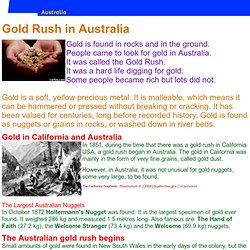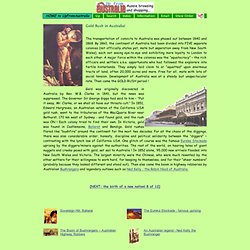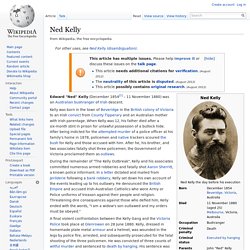

Australian gold rush timeline, Discovering gold, Gold and mining, SOSE Year 6, SA. The first major mineral discovery - gold - was a watershed (a turning point or landmark) for Australian society.

Australian gold rushes. An Australian gold diggings circa 1855 After the California gold rush began in 1848, causing many people to leave Australia for California to look for gold there, the New South Wales government rethought its position, and sought approval from the Colonial Office in England to allow the exploitation of the mineral resources and also offered rewards for the finding of payable gold.[2] The first gold rush in Australia began in May 1851 after prospector Edward Hargraves claimed to have discovered payable gold near Bathurst, at a site he called Ophir.[3] Hargraves had been to the Californian goldfields and had learned new gold prospecting techniques such as panning and cradling.

Gold! Gold Rush in Australia Gold is found in rocks and in the ground.

People came to look for gold in Australia. It was called the Gold Rush. It was a hard life digging for gold. Some people became rich but lots did not. Gold is a soft, yellow precious metal. Gold Rush in Australia! The transportation of convicts to Australia was phased out between 1840 and 1868.

By 1860, the continent of Australia had been divided into FIVE separate colonies (not officially states yet, mate but seperation away from New South Wales), each not seeing eye-to-eye and exhibiting more loyalty to London to each other. A major force within the colonies was the “squatocracy” – the rich officers and settlers a.k.a. opportunists who had followed the explorers into fertile hinterlands. They simply laid claim to or “squatted” upon enormous tracts of land, often 20,000 acres and more. Free for all, mate with lots of social tension. Development of Australia was at a steady but unspectacular rate. Gold rush – Flash interactive. Ancient Australian History. After a long trek on foot or horseback by coach or dray from Sydney or Melbourne, new miners were thankful and excited when they reached the goldfields.

On the larger fields they saw hundreds or even thousands of tents clustered around creeks or near the site of earlier discoveries. There were horses and bullocks, wagons and carts and everywhere people bustling around, digging, panning, washing gravel, moving mounds of dirt or gently rocking their cradles from side to side. New miners soon realised, however, that the goldfields were not as attractive to live in as they looked from a distance. At Bendigo, for example, up to 40,000 people lived close together in tents. They did not have enough water and their toilets were simply holes in the ground.
Miners worked hard day after day and often could afford neither the time nor the money to buy good food. The first diggers lived in tents which they brought with them to the goldfields. Ned Kelly. Edward "Ned" Kelly (December 1854[1] – 11 November 1880) was an Australian bushranger of Irish descent.

Kelly was born in the town of Beveridge in the British colony of Victoria to an Irish convict from County Tipperary and an Australian mother with Irish parentage. When Kelly was 12, his father died after a six-month stint in prison for unlawful possession of a bullock hide. After being indicted for the attempted murder of a police officer at his family's home in 1878, policemen and native trackers scoured the bush for Kelly and those accused with him. After he, his brother, and two associates fatally shot three policemen, the Government of Victoria proclaimed them as outlaws. During the remainder of "The Kelly Outbreak", Kelly and his associates committed numerous armed robberies and fatally shot Aaron Sherritt, a known police informant. A final violent confrontation between the Kelly Gang and the Victoria Police took place at Glenrowan on 28 June 1880.
Family background and early life. Bushranger. History[edit] More than 2000 bushrangers are believed to have roamed the Australian countryside, beginning with the convict bolters and drawing to a close after Ned Kelly's last stand at Glenrowan.[3] 1850s: gold rush era[edit]

Australian Bushrangers. Bushrangers of Australia. Early Australian bushrangers. McFarlane & Erskine, Gold escort attacked by bushrangers, 187-, print: lithograph.

Image courtesy of the : nla.pic-an8420450. Bushranging - living off the land and being supported by or stealing from free settlers - was either chosen as a preferred way of life by escaped or was a result of the lack of supplies in the early settlements. Australia's bushranging period spanned nearly 100 years, from the first convict bushrangers active from 1790 to the 1860s, through the of the 1860s and 1870s who were able to be shot on sight, to the shooting of the in 1880. While many bushrangers had populist reputations for being 'Robin Hood' figures; some bushrangers were brutal and others harassed the and diggers returning from the goldfields.
Australia - The Gold Rush & The Eureka Stockade for Kids - FREE Presentations in PowerPoint format, Free Interactives and Games. The Australian gold rush. JCF Johnson, A Game of Euchre, col. wood engraving, Australasian Sketcher Supplement [Melbourne], 25 December, 1876.

Image courtesy of the : nla.pic-an8927787.